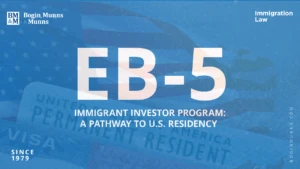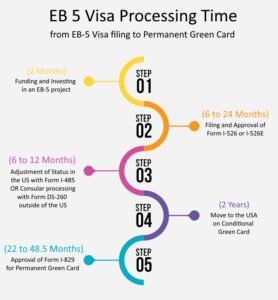
The EB-5 Immigrant Investor Program provides a unique opportunity for foreign investors to obtain U.S. lawful permanent residency by making a significant capital investment in a new commercial enterprise that creates jobs. Established to stimulate the U.S. economy through job creation and capital investment, the EB-5 program has become a popular immigration pathway for those seeking permanent residency in the United States.
Key Requirements of the EB-5 Program
To qualify for the EB-5 program, investors must meet specific criteria outlined by the United States Citizenship and Immigration Services (USCIS):
- Investment Amount: Investors must contribute a minimum of $1,050,000 in a standard commercial project or $800,000 in a Targeted Employment Area (TEA)—a rural area or one with high unemployment.
- Job Creation: The investment must result in the creation or preservation of at least ten full-time jobs for U.S. workers.
- New Commercial Enterprise (NCE): The investment must be made in a new business or an existing business that undergoes substantial restructuring.
- Lawful Source of Funds: Investors must demonstrate that their capital comes from a legitimate source.
- Investment at Risk: The capital investment must be subject to both the possibility of loss and the potential for gain.
- Conditional Green Card: Initially, investors receive a two-year conditional Green Card, during which they must ensure compliance with EB-5 program requirements.
- Path to Permanent Residency: Successful completion of the program leads to a permanent Green Card for the investor and their immediate family.
Understanding the “At Risk” Investment Requirement
A critical element of the EB-5 program is that the investment capital must be “at risk.” USCIS mandates that an investment must have the potential for both gain and loss. Any guarantee of return or contractual agreement ensuring the investor gets their money back disqualifies the investment from meeting EB-5 criteria.
USCIS further specifies that funds cannot be invested through financial instruments such as bonds, convertible debt, or any other secured arrangement. Instead, capital must be actively deployed into a commercial enterprise that engages in commerce and job creation. Additionally, all funds must be allocated to the Job-Creating Entity (JCE) rather than being held in reserve by the NCE.
Investment Sustainment Period
Under the EB-5 Reform and Integrity Act of 2022, investments must remain at risk for a minimum of two years. However, most industry experts recommend a longer sustainment period (5-7 years) to ensure compliance with job creation requirements and USCIS regulations. If an investment does not remain at risk for the required time, it must be redeployed into another qualifying project within the United States. Redeployment must still meet all EB-5 requirements, including active commercial engagement and the potential for loss or gain.
What Happens if a Project Fails?
Like any investment, EB-5 capital carries inherent risks. If a project fails, investors could lose their entire investment. Therefore, conducting thorough due diligence, selecting a reputable Regional Center, and ensuring the project has a sound business model are crucial steps in mitigating risk.
Benefits of the EB-5 Program
Despite its complexities, the EB-5 program offers numerous advantages for investors and their families:
- Pathway to a Green Card: Investors and their immediate family members (spouse and unmarried children under 21) can obtain permanent residency.
- Freedom to Live and Work Anywhere in the U.S.: Unlike other visa categories, EB-5 Green Card holders are not restricted to a specific employer or location.
- Path to U.S. Citizenship: After meeting residency requirements, Green Card holders can apply for naturalization and become U.S. citizens.
To consult with an experienced immigration lawyer today
855-780-9986
The EB-5 Immigrant Investor Program is an attractive option for foreign investors seeking permanent residency in the United States. However, it requires careful planning, a thorough understanding of USCIS regulations, and a willingness to accept investment risks. Working with experienced legal professionals and selecting the right investment project can significantly increase the likelihood of success.
How Bogin, Munns & Munns Expedite the Process.
Navigating the EB-5 program can be complex, but you don’t have to do it alone. The experienced immigration attorneys at Bogin, Munns & Munns can guide you through every step of the process, from investment selection to Green Card approval. Contact us today to schedule a consultation and take the next step toward your future in the United States.
Call or Submit Our Consultation Request Form Today







